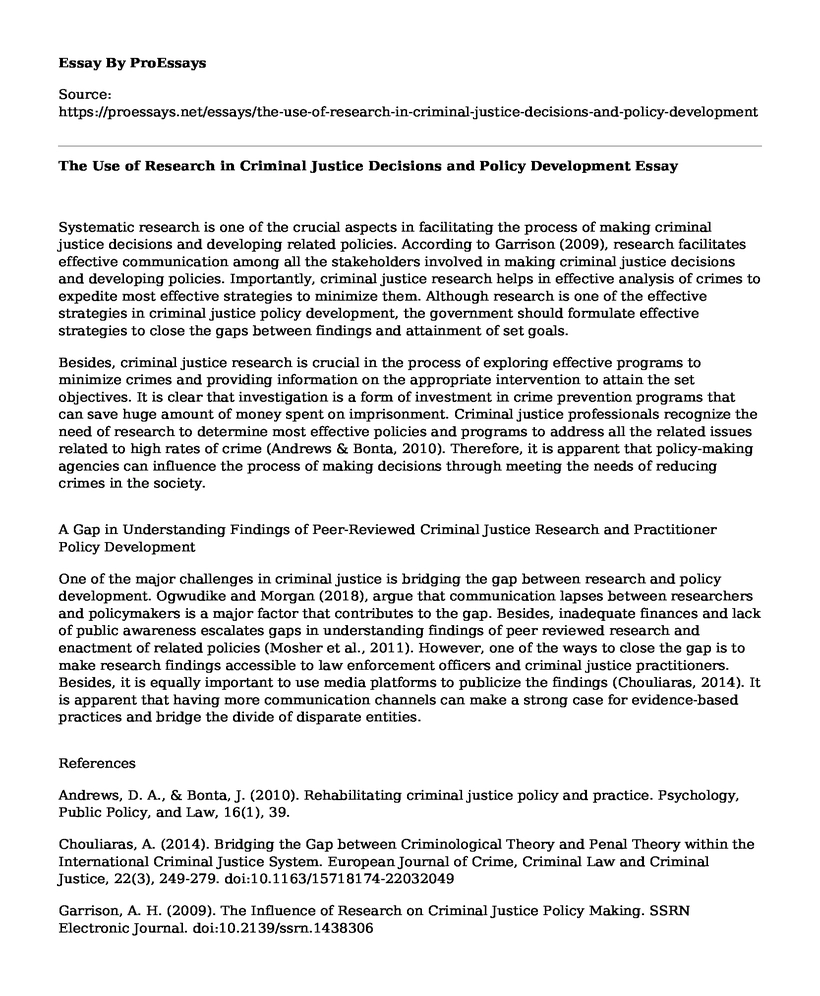Systematic research is one of the crucial aspects in facilitating the process of making criminal justice decisions and developing related policies. According to Garrison (2009), research facilitates effective communication among all the stakeholders involved in making criminal justice decisions and developing policies. Importantly, criminal justice research helps in effective analysis of crimes to expedite most effective strategies to minimize them. Although research is one of the effective strategies in criminal justice policy development, the government should formulate effective strategies to close the gaps between findings and attainment of set goals.
Besides, criminal justice research is crucial in the process of exploring effective programs to minimize crimes and providing information on the appropriate intervention to attain the set objectives. It is clear that investigation is a form of investment in crime prevention programs that can save huge amount of money spent on imprisonment. Criminal justice professionals recognize the need of research to determine most effective policies and programs to address all the related issues related to high rates of crime (Andrews & Bonta, 2010). Therefore, it is apparent that policy-making agencies can influence the process of making decisions through meeting the needs of reducing crimes in the society.
A Gap in Understanding Findings of Peer-Reviewed Criminal Justice Research and Practitioner Policy Development
One of the major challenges in criminal justice is bridging the gap between research and policy development. Ogwudike and Morgan (2018), argue that communication lapses between researchers and policymakers is a major factor that contributes to the gap. Besides, inadequate finances and lack of public awareness escalates gaps in understanding findings of peer reviewed research and enactment of related policies (Mosher et al., 2011). However, one of the ways to close the gap is to make research findings accessible to law enforcement officers and criminal justice practitioners. Besides, it is equally important to use media platforms to publicize the findings (Chouliaras, 2014). It is apparent that having more communication channels can make a strong case for evidence-based practices and bridge the divide of disparate entities.
References
Andrews, D. A., & Bonta, J. (2010). Rehabilitating criminal justice policy and practice. Psychology, Public Policy, and Law, 16(1), 39.
Chouliaras, A. (2014). Bridging the Gap between Criminological Theory and Penal Theory within the International Criminal Justice System. European Journal of Crime, Criminal Law and Criminal Justice, 22(3), 249-279. doi:10.1163/15718174-22032049
Garrison, A. H. (2009). The Influence of Research on Criminal Justice Policy Making. SSRN Electronic Journal. doi:10.2139/ssrn.1438306
Ugwudike, P., & Morgan, G. (2018). Bridging the gap between research and frontline youth justice practice. Criminology & Criminal Justice. doi:10.1177/1748895817753509
Cite this page
The Use of Research in Criminal Justice Decisions and Policy Development. (2022, Dec 05). Retrieved from https://proessays.net/essays/the-use-of-research-in-criminal-justice-decisions-and-policy-development
If you are the original author of this essay and no longer wish to have it published on the ProEssays website, please click below to request its removal:
- Budgeting and Beyond: Literature Review, Approaches, Criticisms
- Research Paper on Theory Of Just War
- Essay Example on Promotional Strategies: Red Bull vs Coca Cola
- Essay on Healthy Eating on a Budget: Peanut Butter, Unsalted Pepitas & Flax Seeds
- Essay Example on 12 Years a Slave: A Detailed Review of Racism, Slavery, and Justice
- Essay Example on Regal Marine's Supply Chain: Challenges & Technology
- Mary Edmonia Lewis: The Pioneering Black American Sculptor - Biography Sample







